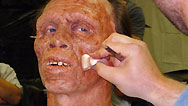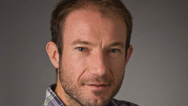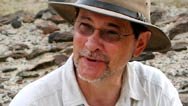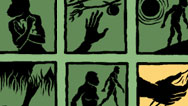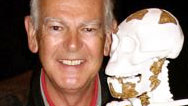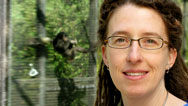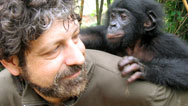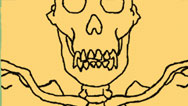
Becoming Human Part 3
Last Human Standing: Many human species once shared the globe. Why do we alone remain? Airing August 31, 2011 at 9 pm on PBS Aired August 31, 2011 on PBS
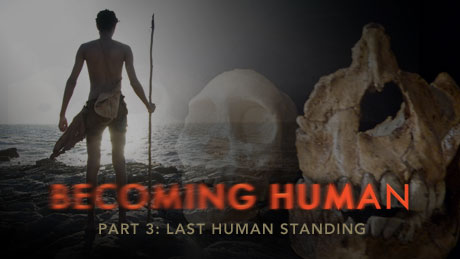
Program Description
Transcript
Becoming Human – Hour 3
PBS Airdate: November 17, 2009
NARRATOR: Humans: without a doubt, the smartest animal on Earth. Yet we're unmistakably tied to our ape origins. Millions of years ago, we were apes, living ape lives in Africa. So how did we get from that to this? What happened? What set us on the path to humanity?
The questions are huge. But at last, there are answers.
More than 6,000,000 years ago we took that first step to separate from the apes. Since then, there have been at least 20 types of human ancestor in our family tree. Some of them were on their way to being us; others were evolutionary dead ends.
DONALD JOHANSON (Arizona State University, Institute of Human Origins): As recently as 50,000 years ago, there were probably four different kinds of humans living at the same time. Yet today, we are a species alone.
NARRATOR: Why did we survive and all the others disappear? New discoveries are shining light on the final stages of our evolution. We're finding out where our species, Homo sapiens, came from.
CURTIS MAREAN (Arizona State University, Institute of Human Origins): The genetic record shows that all modern humans are descended from a small population of approximately 600 breeding individuals.
NARRATOR: And we are discovering how they spread through the world, pushing out other ancient humans like the Neanderthal.
JEAN-JACQUES HUBLIN (Max Planck Institute for Evolutionary Anthropology): Neanderthals were very successful humans. They have lived in Europe for maybe 300-, 400,000 years, but eventually they were replaced by modern humans.
NARRATOR: But why were they replaced by modern humans? The mystery of the Neanderthal disappearance is finally being solved, as the secrets of their genetic code are unlocked.
We're discovering exactly what made them different from us, and how we're unique. So join us, as we explore the origins of our own species. Find out why we're the last human standing, right now on NOVA.
Major funding for NOVA is provided by the following:
(Pacific Life: music, whale and graphics)
Natural gas is a cleaner-burning fuel, yet a lot of natural gas has impurities like CO2 in it. Controlled Freeze Zone is a new technology being developed by ExxonMobil to remove the CO2 from the natural gas so we can safely store it where it won't get into the atmosphere. ExxonMobil is spending more than $100 million to build a plant that will demonstrate this process. I'm very optimistic about it, because this technology could be used to reduce greenhouse gas emissions significantly.
And Merrill Lynch Wealth Management. You can learn more at ml.com/help2.
And David H. Koch. And...
Discover new knowledge: HHMI.
And by the Corporation for Public Broadcasting and viewers like you. Thank you.
NARRATOR: Imagine a world with only a tiny number of us in it, perhaps just a few thousand. A recently evolved species, we are completely at the mercy of the natural forces around us.
One-hundred-forty-thousand years ago, Homo sapiens teetered on the brink of extinction. New discoveries are revealing how, from these humble beginnings, we took over the planet, eventually replacing the other ancient humans who were already living there: Homo erectus and the Neanderthals.
DANIEL LIEBERMAN (Harvard University): Humans have a very intensive way of using the environment. Humans move into the Middle East, the Homo erectus goes extinct. When humans move in to Europe, the Neanderthals go extinct.
NARRATOR: For almost 400,000 years the Neanderthals lived in Ice Age Europe. Superb hunters, they had brains bigger than ours and a record of survival twice as long. They were the most advanced humans on Earth, until we arrived; and then they vanished. Why?
Finally, we're unearthing the answers. The remains of a 100,000-year-old child are revealing what we had that they didn't.
JEAN-JACQUES HUBLIN: ...essential to figure out what are the differences between the Neanderthals and us, to figure out what is special about us.
NARRATOR: Was it some new physical ability or was it a new way of thinking? These questions go to the heart of what makes us human.
Imagine the entire span of recorded human history, taking us back to the Egyptian pyramids, about 5,000 years. Double it: 10,000 years ago, when plants were domesticated and agriculture begins. Double it again: 20,000 years, to the time when Ice Age hunters paint stunning images on cave walls. And keep doubling, six more times, and we are finally entering the world of Homo erectus, the remarkable ancestor who pioneered what it means to be human.
Homo erectus appeared on the African plains almost 2,000,000 years ago. They were the first ancestors who had bodies like ours. They were hunter-gatherers and toolmakers, beings who lived in social groups and cared for each other.
The most famous Homo erectus is the fossil called Turkana Boy.
VIKTOR DEAK (Paleoartist): Well, Turkana Boy and his ancestors, they represent a threshold. They represent that point in our evolution when we were...we weren't quite fully a human but we were no longer an ape.
NARRATOR: Paleoartist Viktor Deak specializes in creating scientifically based sculptures of ancient humans from their fossil remains. As he reconstructs Turkana Boy's head, ape-like features emerge: heavy brow ridges, a protruding lower face, a skull still smaller than our own. But despite these differences Turkana Boy is definitely starting to look like a human being. And behind those eyes, his mind was becoming human too.
VIKTOR DEAK: I suspect that complex feelings and behaviors had their beginnings with Turkana Boy's kind, and that what it is to truly be human had its bubblings at that point.
NARRATOR: It was probably Homo erectus, almost 2,000,000 years ago, who first started to leave Africa. Ever since, Africa has been the engine of our evolution, pumping out wave after wave of ancient humans, who populated Europe and Asia. Settling in far-off places, they developed in their own special ways.
An early wave gave rise, in Indonesia, to the extraordinary Hobbit, perhaps a type of dwarf Homo erectus. Another wave took Homo erectus all the way to China where fossil remains have been dated to over 700,000 years ago. Soon after, another wave left Africa, this time, heading for Europe. This was the species that would one day give rise to the Neanderthals.
Ever since the first skull was discovered, in Heidelberg, Germany, they have been called Homo heidelbergensis. But almost nothing was known about them, until one extraordinary find was made.
Atapuerca in northern Spain: These rolling hills have turned out to be an archeological goldmine. When a railway was built, over a hundred years ago, it cut right through the hills. Archeologists later discovered this had exposed over a million years of ancient human habitation, including the oldest human remains in Europe.
Nearby, on the crest of one of the hills, they also found the entrance to some caves. To explore them took years, but it has been worth it.
They have discovered a labyrinth of chambers and corridors reaching far inside the hills. At the end of the labyrinth is one of the most inaccessible archeological sites in the world, a treasure trove of human fossils they call the "Pit of Bones."
JUAN LUIS ARSUAGA (The Complutense University of Madrid): This is the entrance to the whole system. The pit itself is very far from here. It is a long way; in some places you have to crawl. It is a difficult place to work.
NARRATOR: Today, it takes half an hour of walking, crawling and scrambling in the dark to reach the 50-foot vertical shaft that drops into the pit. But it took almost 10 years for the site to give up its secrets.
JUAN LUIS ARSUAGA: We started to find small pieces of human bones, difficult to recognize in the beginning because they were very fragmentary.
NARRATOR: But so many tiny fragments made them think they were on to something big.
JUAN LUIS ARSUAGA: Even without talking to each other, we started to think that maybe there were, down there, skeletons.
NARRATOR: As bone after bone came out of the pit, they realized they had not one, but many complete skeletons.
JUAN LUIS ARSUAGA: We have around 30 complete skeletons, half a million years old. And this is absolutely unique.
NARRATOR: These are the skeletons of the ancestors called Homo heidelbergensis, one of the earliest to populate Europe. But why were so many complete skeletons collected in one place? Juan Luis Arsuaga believes they were put there intentionally by their kin.
Half a million years ago, the Pit of Bones, now deep underground, had an opening to the surface. Perhaps Homo heidelbergensis dropped the bodies into the pit in a sort of primitive burial. And there is evidence it may have been ceremonial.
Along with the bones, Juan Luis found a single artifact, a hand ax made of pink quartz, a mineral which must have been brought from a long way away. The team called it Excalibur, after King Arthur's famous sword. They believe it was an offering: the first symbol ever found.
If this is right, here were beings with complex minds, capable of symbolism and belief.
JUAN LUIS ARSUAGA: Half a million years ago, in these European populations, there was planning, there was consciousness, there was a human mind, and there was also symbolic behavior.
NARRATOR: We used to think these qualities belonged only to us, Homo sapiens; that the earliest evidence for them was in the painted caves of southern France, just 30,000 years ago. But the extraordinary finds at Atapuerca may have pushed the beginnings of that mental evolution back almost half a million years. Homo heidelbergensis would continue to evolve, eventually becoming the species who would populate Europe, the Neanderthals.
Of all ancient humans, the Neanderthals were the closest to us. Their brains were slightly larger than ours. Their short, heavyset bodies helped them survive repeated ice ages. They were hunters, living off the big game that roamed the edges of the great ice sheets covering Europe and central Asia.
When Neanderthal fossils were first discovered, Darwin had yet to publish his theory of evolution. The idea that modern humans had descended from more primitive forms would generate furious controversy.
MICHEL TOUSSAINT (University of Liege): This is the skull of Engis 2. It is the first Neanderthal fossil ever found on Earth. It was discovered at the end of 1829, but back then people were not happy with the idea that this could be a human being, like us.
NARRATOR: Many claimed that the Neanderthals were just diseased, misshapen humans. Then, as evolutionary ideas took hold, people wondered if they were the missing link between us and the apes.
JEAN-JACQUES HUBLIN: If we go back to the beginning of the 20th century, Neanderthals were seen as sort of apelike creatures.
NARRATOR: But since then hundreds of fossil finds have revealed their physical similarities to us.
JEAN-JACQUES HUBLIN: After the '70s, there was a so-called "rehabilitation" of the Neanderthals. So we tend to see them in a more human way.
NARRATOR: But did they think and act like us?
Today, the remains of a young boy, who died 100,000 years ago, are helping researchers penetrate the mysteries of the Neanderthal mind.
The Meuse Valley in Belgium: It was caves and rock shelters here that gave up the very first Neanderthal fossils, 150 years ago. Today they are revealing deeper secrets of the Neanderthal world.
For over 20 years, Michel Toussaint and Dominique Bonjean have been excavating a cave called Scladina. One millimeter at a time, they've been sifting through the debris that once filled the cave. Their painstaking work paid off.
DOMINIQUE BONJEAN (Archéologie Andennaise): I've had the chance to be present when one of my students has discovered the Neanderthal child. And when we have come there and see that this piece was...we were so surprised! We couldn't believe it.
NARRATOR: What they uncovered was the jawbone of a young boy, 100,000 years old.
Nearby, they found more fragments and teeth, until they had almost a complete mouth.
Since then, they've been trying to reconstruct the life of the boy from Scladina. They know the woodlands and caves of the Meuse valley were his home. He probably lived here with his extended family. Already he would have been learning, from his father, the skills to become a hunter. But what else can we infer about his way of life?
His bones are full of clues, and new techniques are allowing scientists to decipher them.
Michel is taking a piece of the jaw to one of the few places in the world where the tests he needs can be done.
The Max Planck Institute, in Leipzig, Germany, is one of the world's foremost centers for human evolutionary studies. Here, the jawbone of the child from Scladina is put through a high-powered C.T. scan. This allows researchers to peer into the internal structure of the teeth and bone.
JEAN-JACQUES HUBLIN: So this is the mandible that was scanned yesterday, the Scladina mandible. And we have built up what we call a surface model, which is basically a virtual representation of the mandible in a computer. We can separate all the teeth from the bone in this specimen.
The features that we can explore show us how Neanderthal are similar to us in many aspects, but also how they are different.
NARRATOR: The teeth of children are among the most prized of all archaeological finds because only they can tell us how fast those children were growing up.
JEAN-JACQUES HUBLIN: If we look at the pattern of eruption of the teeth, the Scladina child, by modern standards, should be about 11 or 12 years old.
The second molar is almost completely erupted, but when we look at the internal structures of the enamel and dentine, it has been shown that it's in fact much younger. We know that this child died around eight years old.
NARRATOR: Although the boy from Scladina would have looked like us, he probably grew up much more quickly. That means he had much less time for brain development and learning.
But is it safe to assume the Neanderthals were less intelligent than we are? The crucial evidence comes from skulls. Endocasts, impressions taken from the inside of Neanderthal skulls, have revealed brains with many similarities to ours.
RALPH HOLLOWAY (Columbia University): When we look at the Neanderthal endocast, we find a frontal lobe that we can't really differentiate from modern Homo sapiens. The Broca's caps that have to do with the motor control, motor aspects of speech, are thoroughly human in terms of their form.
NARRATOR: So if the front of the Neanderthal brain is similar to ours, what about the rest of it?
Today scientists like Katerina Havarti are trying to measure fossil skulls with new precision. She uses a special instrument to digitize the skulls and create perfect three-dimensional images.
KATERINA HARVATI (Tí¼bingen University): We've know for a long time that Neanderthals looked different from modern humans, ever since they were first discovered and described. But the question, then, become what does this difference actually mean?
NARRATOR: This is a digitized 3-D image of our own skull, with its characteristic high dome. By contrast, the Neanderthal skull is low and elongated, possibly indicating a different brain shape. The parts of the Neanderthal brain called the parietal and temporal lobes may have been slightly smaller. That small difference could have had a large impact on their mental ability.
DANIEL LIEBERMAN: There are regions of the parietal lobes and the temporal lobes that are very important in cognition, particularly in terms of language and memory and remembering spatial locations.
NARRATOR: The reduced size of those regions of Neanderthal brains might be a sign of limited thinking powers. But the boy from Scladina's jawbone has more to tell us about other limitations.
Back at the Max Planck Institute, Mike Richards is delving even deeper into the micro-structure of the bone, to find out about his diet. The food we eat leaves a chemical signature in our bodies. These signatures are incorporated into the protein of our bones.
MICHAEL RICHARDS (Max Planck Institute for Evolutionary Anthropology): So what we do is we get the bone, and we take that protein out and measure those signatures. We can work backwards and say, "This is the food that this human ate over their lifetime."
NARRATOR: He's discovering that Neanderthals were almost exclusively meat eaters, although there were many fruits, berries and edible roots in their environment.
MIKE RICHARDS: We don't see any evidence that plant protein was at all important in their diet, and it doesn't look like they had marine food at all. They were hunting large herbivores like bison or reindeer and things like that.
NARRATOR: They were carnivores with a diet closer to that of a predator like a wolf than a human. And they showed few signs of change, no matter where they lived.
MIKE RICHARDS: So far, we've measured the type specimen from Germany, the Neanderthals from Scladina, Neanderthals from France and Croatia, over about 100,000 years. And in every case, in all these different environments, the Neanderthals do the same thing.
NARRATOR: So the bones of the boy from Scladina and his people are revealing important clues to Neanderthal behavior. They did one thing: hunting large game. And they just kept on doing it for hundreds of thousands of years. Their technology tells a similar story.
JOHN SHEA (Stony Brook University): Neanderthal technology is quick and dirty. It's simple. There's very few tools that Neanderthals made that one can't copy in a few seconds, or even minutes.
NARRATOR: Although they hunted large animals, they didn't have throwing spears or arrows.
JOHN SHEA: None of the stone tools that the Neanderthals made are the size and shape sufficient to be a projectile point. They're all too big, which suggests they're either knives or tips of thrusting spears.
NARRATOR: That meant Neanderthal hunters had to get close to their prey to kill them, which made hunting a risky business. Most Neanderthal male skeletons have multiple fractures. Neanderthal lives were tough, and they were short. Their skeletons tell us that very few lived beyond the age of 30.
But as a species, the Neanderthals were long-lived. They lasted for almost 400,000 years. That's twice as long as we have.
But one day, their time on Earth would come to an end. By 25,000 years ago, they vanish from the fossil record. So what happened?
To find out, we have to return to Africa: the Great Rift Valley, the stage on which so much of human evolution has played out. It was here, millions of years ago that nature began its grand experiment with creatures like Lucy, who walked upright. It was here, just over a million years ago, that Turkana Boy and his kind, with their bigger brains and bodies, formed the first hunter-gatherer societies.
And it was here, about 200,000 years ago that the skulls of a new species start to be found, the last human to evolve, Homo sapiens.
They are still not completely us. Their brow ridges are a little heavier, their faces a little bigger, and their technology is still simple.
JOHN SHEA: You have stone tools made by Neanderthals, and stone tools made by Homo sapiens, and they're identical. You can't tell which one made the stone tools, because they were making the same kinds of tools.
NARRATOR: So what changed? What made us into the versatile beings we are today? All the evidence points to climate upheaval.
CURTIS MAREAN: We enter one of the longest, coldest glacial stages on record.
NARRATOR: Around 200,000 years ago, vast ice sheets descend. In Africa, megadroughts turn much of the continent into a desert.
SPENCER WELLS (National Geographic Explorer-in-Residence): And so, basically, you've got this double whammy of climatic challenges slamming the African population, and the people dwindle.
NARRATOR: Geneticist Spencer Wells believes that ancient population crashes have left a footprint in our genes. It's called the bottleneck effect.
SPENCER WELLS: Humans, although on the surface we seem to be so different from each other, actually have remarkably little genetic diversity. We're 99.9 percent identical. Look at other apes, like chimps or gorillas or orangutans, they have between four and ten times as much diversity at the D.N.A. level.
NARRATOR: The lack of diversity in human D.N.A. is a clue to a crisis that may have wiped out whole populations.
SPENCER WELLS: The reason that we have so little diversity at the genetic level is because we lost it at some point. Imagine that this bottle of jellybeans is the initial population; you've got so much diversity in here. What happens during a bottleneck? When you go through the bottleneck, only a few of the lineages survive. So that's the drop in population size right there.
Everyone alive today is a descendent of these individuals. And you can see that we're missing many of the colors that you see in the initial population. That's how a bottleneck works. And everybody alive today is a descendent of that small number of individuals who made it through the bottleneck.
NARRATOR: Ancient climate data shows that around 140,000 years ago most of tropical Africa became uninhabitable. Our ancestors were forced to seek refuge on coasts and highlands.
CURTIS MAREAN: It looks like four to six potential locations in Africa that would still be supportive of hunter-gatherer populations.
NARRATOR: Despite the refuges, there is evidence our ancestors were pushed to the brink of extinction.
CURTIS MAREAN: The genetic record shows us that we are all descended from a small population of approximately 600 breeding individuals.
NARRATOR: There's disagreement about the numbers and timing, but it does seem that all people on Earth are descended from a very small original population in Africa. Curtis Marean believes they lived on the South African coastline, and that it was life by the sea that forced them to change.
At Pinnacle Point, South Africa, he has found caves used by early Homo sapiens' ancestors during the megadrought period. They are full of clues that hint at new ways of thinking and behaving. Here he has found some of the earliest evidence that humans were living off the sea.
CURTIS MAREAN: This darkish material here is ash from a fireplace, and the vast majority of this material is burnt shell. So, clearly, there is quite a bit of cooking of shellfish that was taking place at this exact spot. Seventy-six thousand years ago somebody had a nice shellfish dinner there.
NARRATOR: Here was a population that was broadening its diet away from meat, requiring ingenuity unknown among earlier ancestors.
CURTIS MAREAN: If you go out to collect shellfish at the wrong time, you're dead. You have to be able to time your access to the coastline so that you're here when the tides are right to collect those shellfish.
NARRATOR: The best time to collect shellfish is at extreme low tides, and to predict those it helps to understand the cycles of the moon.
CURTIS MAREAN: Those are the times that you want to be collecting shellfish, all the shellfish are exposed so this water, which you see here, is out there at that point, where that rock is. So the smart coastal hunter-gatherer knows how to use the moon to signal to them when to come to the coastline to collect the shellfish.
NARRATOR: The people of Pinnacle Point were not just harvesting shellfish. They were also hunting on the plains behind the coast and gathering berries and roots. Their way of life reflected a new versatility.
CURTIS MAREAN: The systematic use of coastal resources does suggest a cognitive complexity.
NARRATOR: Our ancestors occupied these caves for over 140,000 years, leaving behind an amazing record of their transformation.
CURTIS MAREAN: This site documents a change in the way that people made stone tools. At the bottom of the sequence, they made stone tools with this rough quartzite material. And then, right at about 71,000 years ago—which occurs just about there in the sequence—they make a shift to making stone tools on this silcrete, in the form of long thin blades.
Before flaking it, the people here were heating this material in the fire and, through heating it, improved its flakeability. And that was at about 71,000 years ago, about 40,000 years older than that has been found anywhere else in the world.
NARRATOR: The technology of our ancestors was expanding from the single all-purpose hand ax to a variety of lighter specialized tools.
JOHN SHEA: Then they starting making these kinds of things, they made tools with special little points for perforating tasks: this. They made others with special chiseled ends for carving tasks.
NARRATOR: Specialized tools allowed our ancestors to get more out of their environment, but this wasn't the only change.
JOHN SHEA: And, at this point, we begin to see people treating stone tools as symbols. They're making them more complex than they need to be to accomplish a particular cutting task. So, at this point, stone tools are no longer just tools for cutting things, they're instruments of carrying social information about their owners.
NARRATOR: A new type of symbolic consciousness was emerging. The first evidence of decorative art, made from a naturally occurring mineral called red ochre, has been found at Blombos, another cave along the South African coast.
CHRISTOPHER HENSHILWOOD (University of Bergen): While we were excavating, more or less in this area you can see over here, we found a chunk of ochre. And when we brushed up the surface of the ochre, we realized there was actually a design on the one side. And once we looked at it in more detail, held it up to the light, we could see a cross-hatched pattern that had lines zigzagged across the surface of this flat ground surface and also had lines across the top, through the middle, and along the bottom. And you can imagine, it was enormous excitement, because we did not expect to find something that might represent a symbolic image in these 75,000 year-old levels. So this really was an enormous, enormous surprise for us.
NARRATOR: At Blombos, they've also found shells with holes drilled in them, believed to have been used for necklaces. So our ancestors were now wearing ornaments and probably painting their bodies, as well.
CHRISTOPHER HENSHILWOOD: For me, what is really important is here, for the first time, really, ever, we have evidence that people can store information outside of the human brain.
NARRATOR: It is the birth of a new type of human culture, more complex but easier to pass on from generation to generation.
Sixty-thousand years ago, our ancestors emerged with new technology and new culture. Thousands of years of drought had forced them to change. They were ready to explore the world.
As the climate improved, they started to stream out of Africa. They might have been surprised to discover continents already populated by other humans, remnants of earlier, more primitive migrations. As they moved into Asia, they might have come across Homo erectus or the tiny Hobbit.
There's no evidence for such a meeting. But there is one encounter we can be more certain about. As a separate wave slowly moved through the Middle East into Europe, they must have met the Neanderthals.
What were those meetings like?
For many years scientists speculated that early Homo sapiens populations absorbed the Neanderthals through interbreeding. If they did, there would be traces of Neanderthal D.N.A. in our genes today. But there was no way to detect Neanderthal D.N.A., until researchers at the Max Planck Institute set out on a daring scientific odyssey: the quest to sequence the Neanderthal genome.
The human genome contains approximately three billion chemical bases: the As, Ts, Cs and Gs that make up our genes. Mapping that was hard enough. The idea of mapping the genome of a long extinct species, seemed pure fantasy. But that didn't stop Svante Pääbo from dreaming about it.
The first problem was to get D.N.A. from Neanderthal bones over 30,000 years old. In most cases, D.N.A. degrades steadily over time, leaving only minute fragments.
SVANTE PííBO (Max Planck Institute for Evolutionary Anthropology): My group is involved, since over 20 years now, in developing techniques to retrieve ancient D.N.A. from fossils and old bones. And of course always a dream was to do the Neanderthal, our closest relative.
NARRATOR: But finally, taking great care not to contaminate it with their own, they isolated the first piece of Neanderthal D.N.A. Svante's dream is now a reality. He and his team have made a draft of the entire Neanderthal genome. Now scientists all over the world can compare key parts of it to the human genome. And one such comparison is already giving us deeper insight into the Neanderthal brain: the gene called FOXP2.
SVANTE PííBO: It's the only gene we know of today that's involved in speech and language development in humans. We know that because, if one copy is lost in a human due to mutation, we have a severe speech problem.
NARRATOR: When first discovered, FOXP2 created a lot of excitement. Although many animals have the FOXP2 gene, the human version is unique. Some thought it was the gene for language. We now know that complex traits like language are controlled by many genes. Yet researchers agree the human version of FOXP2 is closely tied to some of the basic motor skills necessary for speech.
SVANTE PííBO: And a big question was, of course, is that shared with Neanderthals or not? And when we now look at it in the Neanderthal, indeed it looks to be identical with us.
NARRATOR: It's tantalizing evidence that despite their mental limitations, the boy from Scladina and his people may have been able to speak.
If we share the capacity for language with the Neanderthals, could we both have inherited it from the same source, a common ancestor who gave rise to both species? Who was it?
With a technique called the molecular clock, scientists can now find out. That's because D.N.A. mutates, or changes, at a surprisingly regular rate. By counting the differences in the genetic code of Neanderthal and ourselves, simply comparing the As, Ts, Cs and Gs in our D.N.A., scientists can calculate how long the two species have been diverging.
SVANTE PííBO: We can then estimate when there was a common ancestor population, where some individuals went on to become modern humans, some went on to become Neanderthals. It's in the order of say 300,000 to 400,000 years ago.
NARRATOR: The timing points straight to the intriguing ancestors who left Africa half a million years ago, and buried their dead in the hills of northern Spain, leaving a distinctive pink hand ax at the spot.
This is Homo heidelbergensis, who we now know is our ancestor, too. In Europe, they evolved into the Neanderthal. In Africa, groups that had not yet migrated evolved into Homo sapiens.
So D.N.A. is revealing we share a common ancestor with the Neanderthals. But do we carry some vestige of Neanderthal D.N.A. in our genes, proof that we absorbed them by interbreeding?
JEAN-JACQUES HUBLIN: Some people claim that there are some hybrids of Neanderthals and modern humans. In the genetical record, we don't see clear evidence of that. The big story is that there were Neanderthals that were replaced by other people, and, after a rather short time, we don't see any trace of the Neanderthals in Europe. And certainly, today, we don't see, really, traces of Neanderthal genes.
NARRATOR: With no evidence of interbreeding, it now seems more likely that as our population grew, we simply pushed the Neanderthals out of their environments.
DANIEL LIEBERMAN: Humans have a very intensive way of using the environment. We seem to have the ability to pump out lots of babies, and our babies seem to have a high probability of surviving. So population growth is a really important part of the human adaptation.
NARRATOR: The arrival of Homo sapiens was not the only thing the Neanderthals had to contend with. Europe was gripped by wild climate swings. The Neanderthals were already struggling to survive.
JEAN-JACQUES HUBLIN: Probably the density of Neanderthals in the landscape was very low.
NARRATOR: And there was a good reason for that. Neanderthal technology was limited, and their energy needs were huge.
JEAN-JACQUES HUBLIN: They had these big bodies, these big brains, living in rather cold environments, so we have estimates of their energy consumption every day. It's about 5,000 kilocalories. It's about what someone racing the Tour de France is spending every day.
NARRATOR: But with slimmer, taller bodies, modern humans had lower energy demands and an ever-improving toolkit. They now developed yet another breakthrough technology: projectile weapons, throwing spears.
JOHN SHEA: These are two very different kinds of spears. These are the big heavy wooden spears that Neanderthals and their ancestors used. These are the lighter bone-tipped spears that Homo sapiens used.
These weapons have different kinds of performance characteristics. The heavy spears are effective at a very short range, and they're heavy; you can only carry so many of them in one hand. The bone-tipped spears are lighter, they're more durable, they have a longer effective range.
In essence, the bone-tipped spears that our ancestors used allowed them to hunt a wider range of animals more safely and, therefore, to have a broader ecological niche.
These big, heavy spears, with their weight, their relatively short range, it's like hunting with a pistol. Whereas using these things is like using a semi-automatic rifle: one has more than one shot, one has greater range; it's a more effective weapon.
NARRATOR: Throwing spears allowed our ancestors to go after a wider range of game with less risk to themselves.
JEAN-JACQUES HUBLIN: The modern humans have this trend of intensifying their exploitation of the environment to, sort of, squeezing out everything possible from the environment.
NARRATOR: That trend, already established in Africa, would become more pronounced as our ancestors spread around the world.
Archeologists have been able to track their movements by the extinctions of large animals. In Europe and Asia, the arrival of Homo sapiens coincides with the disappearance of the hairy mammoth, the cave lion and other large mammals. In Australia, most animals weighing over 100 pounds vanish within a few thousand years of our arrival.
JOHN SHEA: The effects of Homo sapiens on large animal communities become more profound as you move further and further from Africa. So, very few major extinctions in Africa, a few of them; a few extinctions associated with Homo sapiens moving into Eurasia; and then, when they hit Australia and the New World, it's a wipeout.
NARRATOR: The Neanderthals were just one of many species that disappeared when we arrived. Gradually, they were pushed into marginal areas of Europe. Their last refuge seems to have been the Rock of Gibraltar, 28,000 years go. Then they vanished, leaving no legacy but their fossilized bones. For the first time there was only one type of human on the planet.
JEAN-JACQUES HUBLIN: But this species, it covered the whole planet, it went to places where other hominids lived, led them to extinction, actually. They went to Australia, they went to America, they went to the moon, and they will go to Mars. And this is very peculiar because the way this species intensified its exploitation of the environment is really unique.
NARRATOR: In the beginning, climate upheavals made us what we are. They taught us a new inventiveness which has led to a cascade of technological advances.
But exactly what made us different is still an enigma. Soon we'll discover the genetic changes unique to our species. But genes are only part of what makes us special. The other part is that mysterious creation unique to humans: culture.
DONALD JOHANSON: Homo sapiens is the most adaptable species in the human career, meaning that no matter what happens in the world, we have a way of adapting to it. Today, that way is called "culture." If glaciers came to Arizona where I live, we wouldn't be growing thick fur and thick skin, we would be building more fireplaces and heating systems.
NARRATOR: Culture is the storehouse of our complex ways of thinking and perceiving, and we pass it on to our children as surely as we pass on our genes. The ways in which cultural evolution and genetic evolution interact will be at the forefront of the research of tomorrow, because one thing is for sure, evolution is not stopping.
SPENCER WELLS: The rate of evolution at the genomic level has increased over the last 10,000 years, and it will probably continue over the next few thousand years.
NARRATOR: Where it will take us, nobody knows, but we're still a young species. There is a long future ahead.
NOVA's got a brand new Evolution Web site, with lots to explore about our ancestors. We want to know what you think. Bookmark it today and give us your feedback. Find it at PBS.org.
Major funding for NOVA is provided by the following:
I've been growing algae for 35 years. Most people try to get rid of algae; we're trying to grow it. The algae are very beautiful. They come in blue and red, golden, green. Algae could be converted into biofuels that we could someday run our cars on. In using algae to form biofuels, we're not competing with the food supply, and they absorb CO2, so they help solve the greenhouse problem as well. We're making a big commitment to finding out just how much algae can help to meet the fuel demands of the world.
To pursue the life you want, sometimes you need a financial advocate who knows where you want to go. A Merrill Lynch financial advisor, now with access to the
resources of Bank of America, can help you diversify, rebalance, imagine and believe: Merrill Lynch Wealth Management.
And by Pacific Life: the power to help you succeed; offering insurance, annuities and investments.
And David H. Koch. And...
Discover new knowledge: HHMI.
And by the Corporation for Public Broadcasting and viewers like you. Thank you.
Broadcast Credits
- Edited by
- Paige Smith Lee
- Written Produced, and Directed by
- Graham Townsley
- Series Producer
- Graham Townsley
- Coordinating Producer
- Kalindi Corens
- Co-Producer
- Anastasia Cronin
- Associate Producers
-
Monica Barrios
Jason Nichols - Original Score
- Joe Delia
- Animation/Special Effects
-
People's Republic of Animation
Pixeldust Studios - Narrator
- Lance Lewman
- Supervising Editor
- Patty Stern
- Additional Editing
-
Virginia Quesada
Jennifer Beman White - Make-up and Prosthetics
-
Matt Rose
Chad Waters - Movement Consultant
- John Alexander
- Camera
-
Reuben Aaronson
Michael Anderson
Stan Barua
Marcus Burnett
Dominic DeSantis
Gary Grieg
Oliver Gurr
Richard Slater-Jones
Gordy Waterman
Brett Wiley - Sound
-
ílex Albors
Zora Katrin Butzke
Sebastian Dunn
Giles Khan
Mark Roy
George Shafnacker
Robert Silverthorne - Location Managers
-
Paul Brehem
Alfonso Par
Sharon Petzold - Series Consultant
- Ann Gibbons
- Color Correction
- Dave Markun
- Online Editor
- Mark N. Boszko
- Sound Design & Mix
- David Kowalski
- Post Production Services
- Henninger Media Services
- Archival Material
-
Artist Web Design
BBC Motion Gallery
The Bridgeman Art Library/Getty Images
Jodi Cobb/National Geographic Image Collection
Viktor Deak
Kenneth Garrett Photography
Katerina Harvati
David Liittschwager/National Geographic Image Collection
Library of Congress
Madrid Scientific Films
Névraumont Publishing Company
Photo Researchers, Inc.
Sweetness and Light
Thought Equity Motion
University of Bergen, Norway - Special Thanks
-
Academy of Art University
Archéologie Andennaise
Institute of Human Origins
Max Planck Institute
National Museums of Kenya
G. Philip Rightmire, Harvard Universtiy
Ian Tattersall, American Museum of Natural History
John Hawks, University of Wisconsin
Smithsonian Institution - NOVA Series Graphic
- yU + co.
- NOVA Theme Music
-
Walter Werzowa
John Luker
Musikvergnuegen, Inc. - Additional NOVA Theme Music
-
Ray Loring
Rob Morsberger - Post Production, Online Editor
- Michael H. Amundson
- Closed Captioning
- The Caption Center
- NOVA Administrator
- Mykim Dang
- Publicity
-
Carole McFall
Eileen Campion
Victoria Louie
Karinna Sjo-Gaber
Karen Laverty - Marketing
- Steve Sears
- Researcher
- Kate Becker
- Senior Researcher
- Gaia Remerowski
- Production Coordinator
- Linda Callahan
- Paralegal
- Sarah Erlandson
- Talent Relations
-
Scott Kardel, Esq.
Janice Flood - Legal Counsel
- Susan Rosen
- Production Assistant
- Ryan Murdock
- Post Production Assistant
- Darcy Forlenza
- Associate Producer, Post Production
- Patrick Carey
- Post Production Supervisor
- Regina O'Toole
- Post Production Editors
-
Rebecca Nieto
Jason York - Post Production Manager
- Nathan Gunner
- Compliance Manager
- Linzy Emery
- Development Producer
- Pamela Rosenstein
- Supervising Producer
- Stephen Sweigart
- Business Manager
- Joseph P. Tracy
- Senior Producer and Project Director
- Lisa Mirowitz
- Coordinating Producer
- Laurie Cahalane
- Senior Science Editor
- Evan Hadingham
- Senior Series Producer
- Melanie Wallace
- Managing Director
- Alan Ritsko
- Senior Executive Producer
- Paula S. Apsell
Produced by Shining Red Productions for NOVA
© 2009 WGBH Educational Foundation
All rights reserved
Participants
- Juan Luis Arsuaga
- Universidad Complutense de Madrid
- Dominique Bonjean
- Archéologie Andennaise
- Viktor Deak
- Paleo-Artist
- Katerina Harvati
- Paleoanthropologist
- Christopher Henshilwood
- Archaeologist
- Ralph Holloway
- Columbia University www.columbia.edu/~rlh2/
- Jean-Jacques Hublin
- Max Planck Institute
- Donald Johanson
- Paleoanthropologist
- Daniel Lieberman
- Harvard University www.fas.harvard.edu/~skeleton/danlhome.html
- Curtis Marean
- Anthropologist
- Svante Pí¤í¤bo
- Max Planck Institute, Leipzig
- Michael Richards
- Max Planck Institute
- John Shea
- Stony Brook University www.sunysb.edu/anthro/staff/jshea.shtml
- Michel Toussaint
- University of Lií¨ge
- Spencer Wells
- Geneticist, Anthropologist
Preview
Full Program | 51:32
Full program available for streaming through
Watch Online
Full program available
Soon

